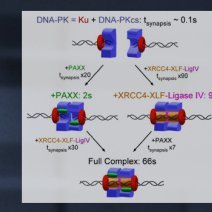Dissection of DNA double-strand break repair using novel single-molecule forceps
Jing L. Wang, Camille Duboc, Qian Wu, Takashi Ochi, Shikang Liang, Susan E. Tsutakawa, Susan P. Lees-Miller, Marc Nadal, John A. Tainer, Tom L. Blundell, Terence R. Strick
Abstract
Repairing DNA double-strand breaks (DSBs) by nonhomologous end joining (NHEJ) requires multiple proteins to recognize and bind DNA ends, process them for compatibility, and ligate them together. We constructed novel DNA substrates for single-molecule nanomanipulation, allowing us to mechanically detect, probe, and rupture in real-time DSB synapsis by specific human NHEJ components. DNA-PKcs and Ku allow DNA end synapsis on the 100 ms timescale, and the addition of PAXX extends this lifetime to 2 s. Further addition of XRCC4, XLF and ligase IV results in minute-scale synapsis and leads to robust repair of both strands of the nanomanipulated DNA. The energetic contribution of the different components to synaptic stability is typically on the scale of a few kilocalories per mole. Our results define assembly rules for NHEJ machinery and unveil the importance of weak interactions, rapidly ruptured even at sub-picoNewton forces, in regulating this multicomponent chemomechanical system for genome integrity.
Nat Struct Mol Biol. 2018 May 21. doi : 10.1038/s41594-018-0065-1


